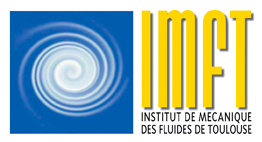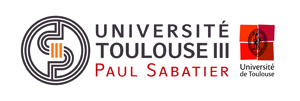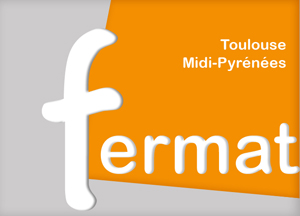Caractérisation des propriétés des composants poreux des piles à combustible à membrane échangeuse de protons en combinant imagerie 3D et simulation numérique
Ahmed Maloum Mohamed El Moustafa
Jeudi 7 décembre 2023 à 13h30 Amphithéâtre Nougaro
Résumé
The performance of proton exchange membrane fuel cells (PEMFC) is closely linked to the microstructure of the gas diffusion layer (GDL) as well as that of the cathode catalytic layer (CCL) and to their transport properties. In this context, the main objective of this thesis is to characterize the microstructure and properties of GDLs and CCLs through the combined use of 3D imaging techniques and numerical simulations. In a first part, we study the diffusion layer (GDL). This is a composite medium composed of a fibrous diffusion medium (GDM) coupled to a microporous layer (MPL). We evaluate the effective diffusion properties of this composite assembly using numerical simulations carried out on three-dimensional images of the microstructures and the GDM/MPL assembly obtained by combining X-ray tomography and scanning electron microscopy coupled with a technique of focused ion beam ablation (FIB-SEM). Using a multi-scale methodology, we characterize the effective diffusion tensor of the MPL. Both Knudsen and Fick diffusion mechanisms are considered. A hybrid approach, combining a continuous description for the MPL with an explicit consideration of the cracks of the MPL and the fibers of the GDM, is used for the calculation of the diffusion coefficient of the GDM-MPL assembly in the through plane direction. We also examine the impact of MPL cracks on the diffusion properties of the assembly using a diffusion resistance model considering the interpenetration of MPL in the GDM, as well as the influence of the compressibility of the GDM.
In a second part, we study the catalytic layer on the cathode side (CCL) based on images of the microstructure obtained by FIB-SEM and by transmission electron microscopy. FIB-SEM imaging makes it possible to differentiate the pores from the solid phase within the limit of the resolution considered (5 nm) but does not make it possible to differentiate the ionomer, platinum and carbon within the segmented solid phase. The study therefore begins with a reconstruction step in which the distribution of the ionomer is reconstructed in the segmented FIB-SEM image by distinguishing the ionomer present in the form of filaments and the ionomer covering the carbon particles. After identification of the filaments, our approach allows to reconstruct the ionomer forming a coating on the carbon phase thanks to a local curvature filtering procedure of the segmented solid surface. This procedure is based on the idea that the concave regions are preferential sites of adhesion of the ionomer on the carbon particles during the drying step of the fabrication of the CCL. The developed procedure makes it possible to reconstruct the ionomer coating with variable ionomer coating thicknesses corresponding to the available experimental data. In a second step, the platinum particles, which are not identifiable in the FIB-SEM images, are distributed on the surface of the carbon phase using a numerical procedure. The reconstruction procedure thus established not only helps understand the microstructure of the CCL, but also allows the numerical characterization of effective properties, such as the oxygen diffusion tensor or the proton conductivity tensor. Moreover, this model allows the calculation of local contact angles from the local ionomer thickness distribution, as well as the evaluation of the CCL capillary pressure curve from the distributions of contact angles and pore sizes.
Francais:
Les performances des piles à combustible à membrane d’échange de protons (PEMFC) sont étroitement liées à la microstructure de la couche de diffusion de gaz (GDL) comme à celle de la couche catalytique à la cathode (CCL) et à leurs propriétés de transport. Dans ce contexte, l’objectif principal de cette thèse est de caractériser la microstructure et les propriétés des GDL et CCL grâce à l’utilisation combinée de techniques d’imagerie 3D et de simulations numériques.
Dans une première partie, nous étudions la couche de diffusion (GDL). Celle-ci est une structure composite composée d’un milieu de diffusion fibreux (GDM) couplé à une couche microporeuse (MPL). Nous évaluons les propriétés effectives de diffusion de cet assemblage composite à l’aide de simulations numériques réalisées sur des images tridimensionnelles des microstructures et de l’assemblage GDM/MPL obtenues en combinant tomographie par rayons X et microscopie électronique à balayage couplée à une technique d’ablation par faisceau d’ions focalisés (FIB-SEM). En utilisant une méthodologie multi-échelle, nous caractérisons le tenseur de diffusion effective de la MPL. Les mécanismes de diffusion de Knudsen et de Fick sont tous deux pris en compte. Pour le calcul du coefficient de diffusion à travers le plan de l’assemblage GDM-MPL une approche hybride est utilisée. Elle combine une description continue pour la MPL avec une prise en compte explicite des fissures de la MPL et des fibres du GDM. Nous examinons également l’impact des fissures de la MPL sur les propriétés de diffusion de l’assemblage à l’aide d’un modèle de résistance à la diffusion considérant l’interpénétration de la MPL dans le GDM, ainsi que l’influence de la compressibilité du GDM.
Dans une seconde partie, nous étudions la couche catalytique coté cathode (CCL) en nous appuyant sur des images de la microstructure obtenues par FIB-SEM et par microscopie électronique en transmission. L’imagerie FIB-SEM permet de différencier les pores de la phase solide dans la limite de la résolution considérée (5 nm) mais ne permet pas de différencier le ionomère, le platine et le carbone au sein de la phase solide segmentée. L’étude commence donc par une étape de reconstruction dans laquelle la distribution du ionomère est reconstruire dans l’image FIB-SEM segmentée en distinguant le ionomère présent sous forme de filaments et le ionomère recouvrant les particules de carbone. Après identification des filaments, notre approche permet de reconstruire le ionomère formant un revêtement sur la phase carbone grâce à une procédure de filtrage de la courbure locale de la surface solide segmentée. Cette procédure repose sur l’idée que les régions concaves sont des sites préférentiels d’adhésion du ionomère sur les particules de carbone lors de l’étape de séchage de la fabrication de la CCL. La procédure développée permet de reconstruire le revêtement du carbone par le ionomère avec des épaisseurs de revêtement variables correspondant aux données expérimentales disponibles. Dans une seconde étape, les particules de platine, qui ne sont identifiables dans les images FIB-SEM, sont réparties à l’aide d’une procédure numérique sur la surface de la phase carbone. La procédure de reconstruction ainsi établie aide non seulement à comprendre la microstructure de la CCL, mais permet également la caractérisation par voie numérique de propriétés effectives, telles que le tenseur de diffusion de l’oxygène ou de conductivité protonique. De plus, ce modèle permet le calcul des angles de contact locaux grâce à la distribution locale d’épaisseur de ionomère, ainsi que l’évaluation de courbe de pression capillaire de CCL à partir des distributions des angles de contact et des tailles de pores.
Abstract :
Arctic environments are the regions that see the most significant climate warming of the Northern Hemisphere. These wetlands are widespread in Arctic ecosystems due to the large accumulation of organic matter (peat) produced by the organisms found there, Sphagnum mosses and lichens. The presence of large amounts of permanently frozen soil horizons (permafrost) makes these environments vulnerable. Numerous signals (increasing average annual temperatures, precipitation anomalies, changes in plant diversity) can already be observed. Climate projections for the year 2100 predict increases in temperature and precipitation in northernmost Arctic regions. These increases lead to the activation of climate feedback loops, which in return amplify climate change. The aim of this thesis is to study the low vegetation cover of Arctic wetlands (Sphagnum, lichens, peat) by considering them as a porous medium. A set of experimental and numerical techniques for studying porous media will be applied to samples from several sites: Khanymey (Siberia) as first place, but also Abisko (Sweden). Some samples from Clarens (France) are collected to serve as test samples. The samples are digitally
reconstructed using X-ray tomography. The digital reconstruction is then used to study the morphological (§I), hydraulic (§II) and thermal (§III) properties of this biological porous medium.
(§I) The morphological study shows a high porosity (sometimes more than 90%) for Sphagnum, lichen, and peat samples. High specific surface areas indicate a significant exchange and absorption potential for the study of element transfer. Representative Elementary Volumes (REV) may be defined for a majority of the samples.
(§II) The simulation of a single-phase flow is used to compute the effective permeability of the studied samples. Samples with a REV are studied by direct numerical simulation at the REV scale. For samples without REV, a pore network is generated from the sample reconstruction. In both cases, the obtained values of the effective permeability tensor show a high hydraulic conductivity. The results are similar to other experimental tests reported in the literature and make it possible to overcome the problem of sample compressibility.
(§III) The thermal properties are characterized using a coupled experimental and numerical approach. The experimental approach consists in studying the steady-state conductive heat transfer. The characterization of the effective thermal conductivity highlights the insulating property of the Arctic vegetation cover, with consistent values between each type of sample. The value of the intrinsic thermal conductivity of the plant material is calculated by inverse modeling of the experiments.
Taken together, these transfer property studies provide a solid basis for generating an effective boundary condition for Arctic vegetation cover. However, further work is needed, in particular to quantify the influence of solar radiation flux on the energy balance of the Arctic vegetation cover. To this end, a preliminary work is presented that confirms the
need for further information on the radiative transfer properties of this porous biological interface.
Thèse dirigée par Manuel MARCOUX et Laurent ORGOGOZO
Jury
- M. Hotaek PARK, Rapporteur
- M. Laurent OXARANGO, Rapporteur
- Mme Sophie OPFERGELT, Examinatrice
- M. Michel QUINTARD, Examinateur
- M. Manuel MARCOUX, Directeur de thèse
- M. Laurent ORGOGOZO, Co-directeur de thèse
- M. Oleg POKROVSKY, invité
- Mme Laure GANDOIS, invitée





